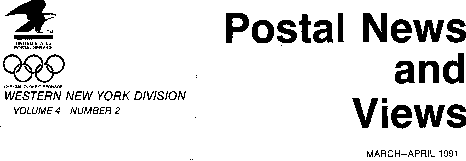



The laboratory offices are modest--one might say even small compared with the casual visitor's expectations. Shelves are stocked with scholarly papers delivered at prestigious academic conferences. Rooms are filed with textbooks, copiers, and photographic equipment. Computers are everywhere-- just what you'd expect in this center, located within one of the nation's premier research universities.
The professors and graduate assistants who labor here resemble their surroundings--rather unassuming. They do not display any arrogance about the enormity and importance of their research, but they clearly demonstrate a genuine enthusiasm for their work which is probably nurtured by its obvious practical applications in the real world.
They are researchers at the State University of New York at Buffalo's Center for Document Analysis and Recognition. Their work: developing computers that can read handwriting. Their relationship with the Postal Service: USPS has recently established at the Fourth Advanced Technology Conference in Washington in November, 1990.
The goal of the center, under the direction of Sargur Srihari, Ph.D., UB professor of computer science, is to substantially advance the "state-of-the- art" in document analysis and recognition by developing technologies that can be applies to the automation of mail processing. In simple language: OCRs that can read handwritten addresses, Srihari has conducted pattern recognition research for the Postal Service at UB since 1985 through a series of competitively awarded contracts.
In announcing the establishment of the center, Postmaster General Anthony Frank said, "Reading poorly-written or typed addresses involves the same technology required to read poorly-written text. Banks and insurance and credit-card firms, as well as many government agencies, have a need to read vast quantities of handwritten and machine-printed documents."
Once the desired equipment is perfected, he added, the Postal Service is expected to realize potential savings of between $230 and $260 million annually in processing costs for letter mail.
In its work for the Postal Service, the University at Buffalo group has worked toward developing technologies that will not only allow machines to find and read addresses, but also sort the mail, making the same relationships between cities, states, and zip codes that human operators do.
"We're trying to get the machines to read a little more like humans." said Srihari.
One of the scientists' goals has been to develop a system that will be able to recognize and understand all addresses, whether printed or handwritten, at the rate of 12 pieces of mail per second. Current systems reject 40 to 50 percent of the mail they scan because they cannot distinguish addresses from other writing on a piece of mail, and because they cannot read handwritten addresses.
To get computers to "read" a handwritten address, Srihari and his colleagues have had to start with the most basic problem: getting the optical character reader to differentiate the address block from the rest of the writing on a piece of mail, such as a magazine, advertising circular, or newspaper.
Initially, the software running on a conventional workstation took 20 minutes to locate the address on a single piece of mail but the scientists reduced that to about a minute. To reach their current target--machines that read and sort 12 pieces of mail per second--they are concentrating on hardware modifications, such as the redesign of integrated circuit chips and boards, as well as the development of new software.
The technologies being developed at the center will have wide application outside of the Postal Service. Several government agencies have expressed interest in optical character readers because of the large volume of documents they are required to digest and the lack of staff to do it. And foreign car companies would like to develop a car that could actually read road signs about speed limits and routes, and then warn drivers if they are going too fast or have traveled off-course.
Now for the big question: how soon will it be before this technology becomes reality?
"It's a long way off," said Srihari. But he and his colleagues are after all, unassuming types. Don't bet the farm against it happening sooner than anyone expects.